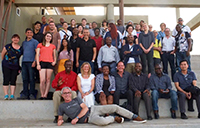A group of masters of environmental studies (MES) students spent 11 days in October on a field course in Johannesburg, South Africa as part of the Critical Urban Planning Workshop.
The graduate course gave 11 MES students the opportunity to participate in the Global Suburbanisms Project, a research project led by York University Professor Roger Keil and funded by the Social Sciences and Humanities Research Council of Canada (SSHRC). The course was taught by Professor Ute Lehrer, one of the major collaborators on the research project and a professor at York University.

To prepare for the overseas project, MES students met once a week leading up to the trip to discuss everything from safety measures, the weather and itineraries to intellectual course content on housing, land and growth boundaries.
In anticipation of their meetings with planners, politicians, academics and activists, the students read a good number of scholarly papers.
On Oct. 16, the group arrived in Melville, an old suburb just outside of Johannesburg’s city centre, to find spring in full bloom.
Shortly after arriving, the students met with the first group of experts in the field of urban planning and quickly realized that not everything in the city is as beautiful in South Africa as the Jacarandas in spring.
They were reminded of the legacy of apartheid and its ongoing effects on the social, physical, economic, and cultural fabrics of South Africa. Their experience in Johannesburg included a trip to the famous Apartheid Museum, and provided students with an unforgettable opportunity to learn about the challenges of urban planning in a post-apartheid city.
Under the 46-year apartheid regime in South Africa, racial segregation was politically legislated. Schools, businesses, workplaces, bathrooms, and even phone booths were separated by race. Each person was given a racial designation on their identification card, but this was often arbitrary, a label given by a government official after a quick visual assessment. Though apartheid ended in 1994, its influence is felt everywhere – in political decisions, in the income gap, in social relations and, most significantly for the students’ purposes, in the physical layout of the city, which was heavily improved during apartheid.

The students began their endeavors in Johannesburg with a three-day workshop organized by the University of Witwatersrand in collaboration with York University. It included a day-long bus tour of various suburbs surrounding central Johannesburg in the Gauteng Province, and visits of New Town, Rosebank and Diepsloot, with many other stops before arriving at Cosmo City, a pilot project neighborhood of integrated development. There, students met with current and former councillors, who explained the details of the integrated housing project.
The next two days were spent at the “Africa’s New Suburbanisms” conference at the Johannesburg Institute for Advanced Study, where students listened to various experts present their research on African suburbanisms. Topics ranged from models of affordable suburbia in Johannesburg to suburban gardening, and the role of walls in the production of safety in the suburbs. On the second day of the conference, students had the opportunity to provide a North American perspective to the conference by giving a presentation on urban planning in Toronto.
The remainder of the trip was spent touring distinctive areas around the city in a minibus taxi – a large white van that is the most common means of transport for Jo’burgers. They studied a range of settlements, from townships such as Wattville to high-income gated communities such as Eagle Canyon and everything in between.

Since their return home, the eleven students (Nabeel Ahmed,Carmen Charles, Ying Gu, Victoria Moore, Orli Schwartz, Patrycja Jankowski, Joyce Chan, Ryan Adamson, Assya Moustaqim-Barrette, Floyd Heath and Steve Closs) have been working in collaboration to produce a report drawing on their experiences and research in Johannesburg.
In their discussions, they have determined that, despite the different geographic, social and other contexts between Johannesburg and Toronto, the two cities are facing many of the same planning challenges. Some of these challenges include the provision of affordable housing in a city that has severe social and economic disparities, developing a sufficient integrated transit system, and managing peripheral growth.
Both cities are also subject to contestation between housing and planning departments, and debates surrounding the prioritization of development in the core versus development on the urban edge.

Written with files from Victoria Moore, Ying Gu, Assya Moustaqim-Barrette and Steve Closs


